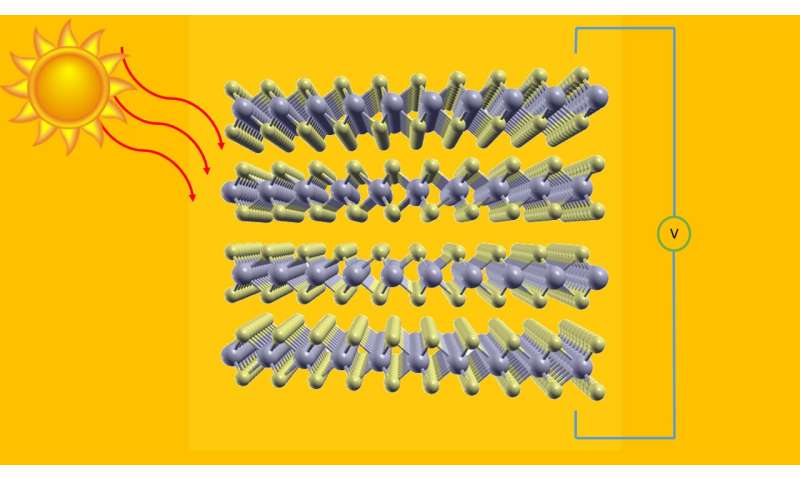How thin do you want your layered materials for maximum solar cell efficiency?

The study of layered materials is a popular scientific topic, especially since the 2010 Nobel prize in physics was awarded to producers of graphene, a two-dimensional material composed of carbon atoms obtained from the layered material graphite. Layered materials have many applications such as electrochemical batteries, transparent conductors, smart windows, transistors, and others.
Popular examples for semiconductor layered materials are transition metal dichalcogenides. A monolayer of these materials consists of a three-atom-thick layer. Transition metal elements are Mo and W, and dichalcogenide atoms are S, Se, and Te. For example, the most popular transition metal dichalcogenide is MoS2. Layered materials have two special characteristics: First of all, they can be easily exfoliated to obtain nano-materials or 2-D materials. Secondly, due to quantum confinement effects, new phenomena can emerge.
Recently, we have shown that layered material transition metal dichalcogenides can be used as a solar cell for the first time. There have been previous accounts of solar cells made from 2-D materials, however, they demonstrated very low efficiency. We calculated the thickness dependence of solar cell efficiency in transition metal dichalcogenides. We introduced light absorbance of the material in the solar cell equation, which enabled us to calculate the thickness-dependent solar cell efficiency. In the Shockley-Queisser limit calculation of solar cell efficiency, there is no absorbance term. In this method, it is assumed that there is 100% light absorption above the band gap of the material.
However, there are two problems with this assumption. One is that there is reflectance above the band gap of the material that is not taken in to account. Secondly, there is tail of the dielectric function below the optical gap of the material, which causes significant absorption below the optical gap for thick enough materials. We showed that a 100-micrometer-thick WS2 solar cell has efficiency 36% higher than silicon; additionally, 100-nm-thick MoTe2 has solar cell efficiency of about 20%. We showed that at 3 micrometers thick, trends change and WS2 becomes the highest-efficiency solar cell and tellurides are the lowest-efficiency. We showed that upon using an ideal anti-reflecting coating working in the entire solar spectrum, it is possible to achieve 66% efficiency. W and S are abundant on Earth, WS2 is inert, non-corrosive, and non-toxic; therefore, WS2 is suitable for large-scale solar cell applications.
This story is part of Science X Dialog, where researchers can report findings from their published research articles. Visit this page for information about ScienceX Dialog and how to participate.
More information:
Burak Ozdemir et al. Thickness dependence of solar cell efficiency in transition metal dichalcogenides MX2 (M: Mo, W; X: S, Se, Te), Solar Energy Materials and Solar Cells (2020). DOI: 10.1016/j.solmat.2020.110557
Bio:
Burak Ozdemir graduated from Middle East Technical University with bachelors and master degrees in physics. After that, he attended Central Michigan University, U.S., where he obtained his Ph.D in materials science. Now, he works as a post-doc at the Physics Department of the University of Ostrava, Czech Republic.